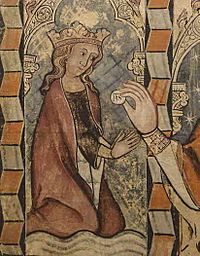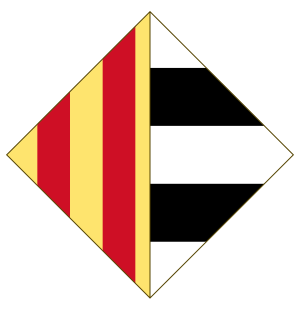Sibila de Fortià facts for kids
Quick facts for kids Sibila de Fortià |
|
|---|---|

Image of Sibila of Fortià in San Miguel de Daroca
|
|
| Queen consort of Aragon | |
| Tenure | 1377–1387 |
| Coronation | January 1381 (Zaragoza) |
| Died | 24 November 1406 Barcelona, Catalonia, Spain |
| Burial | Sant Francesc (Framenors) Pantheon of Poblet Cathedral of Barcelona |
| Spouse | Artal de Foces Peter IV of Aragon |
| Issue | Isabella, Countess of Urgel |
| Father | Berenguer de Fortià |
| Mother | Francesca de Vilamarí |
Sibila de Fortià was a Queen of Aragon who lived a long time ago. She was born into a family called Fortià. They were not super rich or famous, but they owned land in a place called Empordà. Sibila became the fourth wife of King Peter IV of Aragon. She was an important queen in the history of Aragon.
Contents
Early Life of Sibila
Sibila was known for being very beautiful when she was young. She first married a man named Artal de Foces. We don't know exactly when they got married.
After her first husband died, Sibila became a lady-in-waiting. This meant she helped the queen, Eleanor of Sicily. Eleanor was King Peter's third wife. Sibila worked for Queen Eleanor when the royal family was staying in Sibila's home area, Empordà.
Queen Eleanor passed away in 1375. She had two sons and one daughter who were still alive.
Soon after Eleanor's death, Sibila caught the eye of King Peter. Sibila was in her twenties, and King Peter was 56 years old. When the king's sons, Martin and John, found out about their father's interest in Sibila, they were not happy. They worried that if their father married again, it could cause problems for who would become king next. The news of the king wanting to marry Sibila made things tense between him and his sons.
Becoming Queen of Aragon
On October 11, 1377, Sibila married King Peter IV of Aragon in Barcelona. This made her his fourth wife and the new Queen of Aragon.
Some people believe that Sibila had a son named Alfonso before she married the king. This child only lived for about a year. However, some historians are not sure if this child really existed. The only record of his birth is in a book called the Chronicle of Peter IV of Aragon.
Sibila and King Peter had three children together:
- Alfonso of Aragon (1376 – 1377), who was called the Count of Morella.
- Peter of Aragon (born and died in April 1379).
- Isabella of Aragon (1380–1424). She grew up and married James II of Urgell. Isabella later became the mother of Isabella of Urgell, Duchess of Coimbra. Through Isabella, Sibila and King Peter are ancestors to important people like Joana, Princess of Portugal and John II of Portugal.
As time went on, the situation at court became more difficult. Sibila's family members were invited to live at the palace. The king started to show special favor to Sibila's brother, Bernard. This created two main groups, or "factions," at court. One group included King Peter, Sibila, and her family. The other group was made up of King Peter's son and heir, John, his French wife Violant of Bar, and their supporters.
Life After the King's Death
King Peter died in 1387. After his death, John and Violant became the new King and Queen of Aragon. They wanted Sibila to leave the court. For her own safety, Sibila quickly went to Sant Martí Sarroca. This was a place where her stepdaughter, Eleanor of Aragon, had lived before she died.
Sibila did not stay there for long. King John and Queen Violant ordered her to return to Aragon. They did not harm Sibila. Instead, they sent her to live in Barcelona. She was watched closely, but she was treated better there than she had been at the royal court.
After King John died in 1396, his brother Martin became the new king. Sibila continued to live in Barcelona.
Death and Burial
Sibila passed away in Barcelona on November 24, 1406. King Martin ordered a special state funeral for her. She was first buried in a church called the convent of San Francisco (Framenors) in Barcelona. This was a traditional burial place for kings and queens of Aragon. Later, her remains were moved to the pantheon of Poblet.
In the 1800s, the convent of San Francisco was torn down. On April 20, 1852, Sibila and others were reburied at the Cathedral of Barcelona. She was first placed in a box built into the wall of a chapel. This was done by Isabella II of Spain. Then, on October 13, 1998, her box was moved again. It was placed inside the main church, on the wall to the left of the main altar.
See also
 In Spanish: Sibila de Fortiá para niños
In Spanish: Sibila de Fortiá para niños


